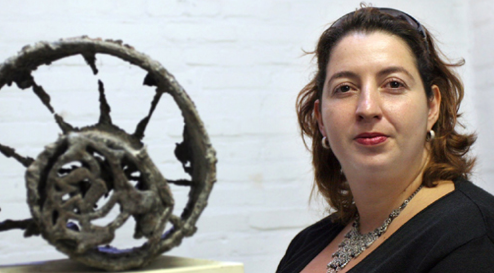There’s an unforgettable message in the cremation urn of Dutch designer Nadia Gonegaï. Art can bring vitality to everything, including end of life. The designer’s “Portrait Urn” was featured by Designboom’s Design for Death competition (of which SevenPonds has been a fond spectator) in 2013.
What sets apart this Dutchwoman’s urn is the fact that it not only contains the remains of a loved one, but projects their very silhouette. Gonegaï explains how her urn’s form takes the profile of a loved one and projects it by shadow:
“De Portret urn is op het eerste oog een alledaagse urn met een sterk reliëf. Maar wie verder kijkt, kan ook het silhouet van een gezicht ontwaren; het gezicht van de dierbare overledene.”
“The Portrait urn is at first glance an everyday urn with a strong relief. But those who look further, one can discern the silhouette of a face…the face of the beloved deceased.”
–Dutch designer Nadia Gonegaï
The Portrait Urn’s standard size is 25-30 centimeters high and can be made of synthetic resin, bronze and a variety of other materials. It depends, says Gonegaï, on what material speaks to you and the memory of the deceased. Was grandfather an outdoorsman? Go for the earth-toned “neolith” urn. Conversely, you can opt for a baroque feel with the “gilded” option.
“Gonegaï’s urn takes the profile of a loved one in its form and projects it by shadow.”
But just how, we wondered, does the designer make a mold of someone’s face after they have passed on? Gonegaï’s website provides a video (see below) demonstrating the process for her curious public. Turns out all she needs is a photo of the loved one’s profile.
“Every man, every life [and death] is unique,” reflects Nadia Gonegaï on her decision to take on the Portrait Urn project, adding that “Nothing is as personal as a face. A single glance at a person’s profile is often enough to recognize someone. I wanted to do something with that.”
“But just how, we wondered, does the designer make a mold of someone’s face after they have passed on?”
Life after the death of a loved one is an adjustment to a surreal state of being, as their absence is felt in even the littlest moments of our days – a footstep in the hall, a glance at a doppelganger in the street – that makes moving forward feel onerous if not momentarily impossible. It’s hard to say whether Gonegaï’s urn indulges in this state or challenges it. We’re used to living with images of loved ones who have passed on, but there is something about the recreation – the endurance – of their shadow that can strike a perverse cord.
What do you think? Would Gonegaï’s urn simply take some getting used to? We look forward to your comments below.
Related SevenPonds Articles:
- A Design for Death concept that transforms a loved one into rain after their passing.
- A Design for Death creation that integrates SMS technology with an “urn vault.”
- Design for Death’s “Urn for Cremation Burials Under Water.”

 Life & Death Silhouetted: Designboom’s “Portrait Urn”
Life & Death Silhouetted: Designboom’s “Portrait Urn”





 Sky Lanterns Bear Wishes and Remembrance into Night Sky
Sky Lanterns Bear Wishes and Remembrance into Night Sky
 ”The Snow Sister” Directed by Cecilie Askeland Mosli
”The Snow Sister” Directed by Cecilie Askeland Mosli















